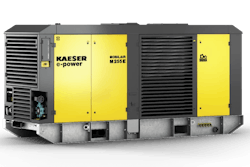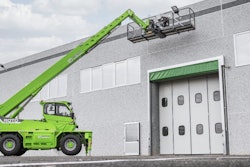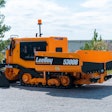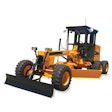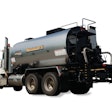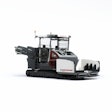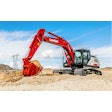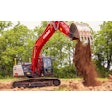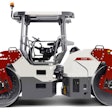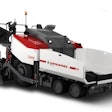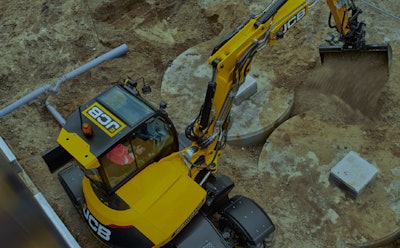
Operating within and around urban environments presents additional threats that must be mitigated to not only enhance site safety but also decrease downtime.
Beyond the consideration of materials cost is the cost of operating machines, towing vehicle rentals, fuel costs, and maintenance costs, the latter in both financial and time of staff to complete the maintenance.
With operator and worker safety the number-one priority on every construction site, municipalities face a juxtaposition as the market demands a curtailing of time and resources for each job to remain within budgetary constraints. Believing that there should not be a trade-off between safety and efficiency, JCB set out to create the most innovative solution to today’s biggest challenges. Their innovations questioned what is deliverable when we manufacture machines that prioritize worker and bystander safety, maximize efficiency and increase uptime.
Around the globe, countless challenges arose over the last several years that no one had faced before. Today, some of those same challenges exist and join economic forecasts to spell concern for the construction industry. With remote work continuing to become the norm, interest rates continuing to rise and inflation stemming consumer demand for products, construction operations look ahead at what could be significant downturns in residential, office, and warehouse construction in 2023. Serving to compound the uncertainty of what is in store in the coming months, the construction industry continues to experience a labor shortage: impacting efficiency and requiring more out of each worker. Further, supply chain disruptions continue to drive up material costs as well as push project completion dates.
For municipalities, these challenges compound: community growth stagnates or withers as consumer spending declines, and economic development ceases or stalls as consumer demand decreases.
Meanwhile, congress has passed the Infrastructure Investment and Jobs Act to invest $1.2 trillion into infrastructure programs—providing opportunities to enhance existing roads, bridges, rail, etc. Today, market conditions require machinery that can be applied to multiple job sites or environments without hesitation.
It requires machinery that is purpose-built to get the job done efficiently, designed to be maintained cost-efficiently and manufactured with operator safety top of mind. From east to west, north to south, municipalities require machinery that prioritizes worker and bystander safety, maximizes efficiency, and increases uptime. To achieve these goals, the machine must solve for safety, shrinking labor force, mobility, and serviceability so that municipalities can develop their communities efficiently despite looming challenges. Meet the JCB Hydradig 110W.
SAFETY
With space at a premium, compact dimensions and all-around visibility are vital. The Hydradig gives operators not only the ability to see all four wheels and ground level beyond a three-foot perimeter. Further, its 109 hp Tier 4 Final JCB EcoMAX engine and other components are housed in the chassis, while reducing the counterweight to ensure a tail swing of just five inches. With municipal projects taking place day and night, JCB’s low-level glass and optional LED work lights make the Hydradig easier to operate in tight, crowded work sites both day and night.
Often, traditional wheeled excavators don’t offer the best visibility, which increases the risk of an accident on site. The Hydradig allows unobstructed in-cab visibility to all four wheels, the dozer blade, the tow-hitch, and any fitted attachments. With a kingpost coming as standard, you can even offset the boom and dipper giving the operator not only a clear line of sight to their attachment but also their direction of travel. Whether working on a road project from a single lane or on a remote work site in the dark of night, the Hydradig lets operators see more to keep them safe on every job.
SHRINKING LABOR FORCE
With the pool of operators getting shallower and the market becoming more competitive, productivity is forced to be placed on hold until operators can be free from duties on other sites. Hydradig tackles this issue head-on with its all-in-one approach. One fully trained operator can achieve multiple different tasks on site without the need to draft in ancillary manpower. With a five-inch tail swing, the Hydradig can easily operate within the confines of a highway shoulder, freeing other workers to complete tasks at other sites.
MOBILITY
Time is money. Sitting idle or spending more time transporting your machine between sites means projects going over budget. Travel to and between sites quicker with a top speed of 25 mph and a stepless transmission from a 109 hp ECOMAX engine on your JCB Hydradig. Made so you can “get in and go,” it features a start-stop button, as well as auto idle as standard to reduce revs, which saves you fuel.
The Hydradig features three mobility modes so you can tackle any task:
• Highway mode isolates the upper structure and dig end for traveling at up to 25 mph.
• Site mode limits the machine to 12.4 mph with all hydraulic services active.
• Creep mode engages a speed limiter for the most precise jobs.
The days of waiting on an additional machine to transport attachments or site equipment are over with Hydradig’s single-speed, hydrostatic transmission. Its 7,700 lb towing capacity on a factory-fit trailer installation lets you be first to and around the site. This one machine eliminates the need to rent or purchase a trailer and towing vehicle. Additionally, using a single machine also eliminates fuel and maintenance expenses for a towing vehicle, and allows a single worker to complete the task at hand without switching machines or increasing staffing.
SERVICEABILITY
Your equipment is an investment in your productivity. Productivity requires you have confidence that your machine will run every time you start it, that it can handle each load with ease, and maintenance is not burdensome.
Designed like every JCB machine to be easy to maintain, the Hydradig:
• Ensures service points are accessible at ground level
• Delivers 500-hour greasing on all dig end, dozer and stabilizer pivot points
• Boasts a best-in-class SAE service index rating—33% better than the closest competitor
The Hydradig includes a five-year JCB LiveLink contract as standard. LiveLink from JCB is the fastest way to ensure your machines are well-maintained without visiting each site to inspect your machine. Plan maintenance schedules in advance to maximize uptime with instant notifications when servicing is due or a critical alert is detected. Additionally, JCB LiveLink gives you peace of mind with real-time geofencing alerts so you know if a machine is moved or operated after your curfew hour. Simply put, JCB LiveLink increases uptime, reduces admin and lets you make better decisions with complete control over your entire fleet.

